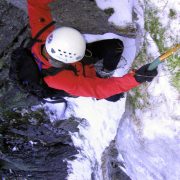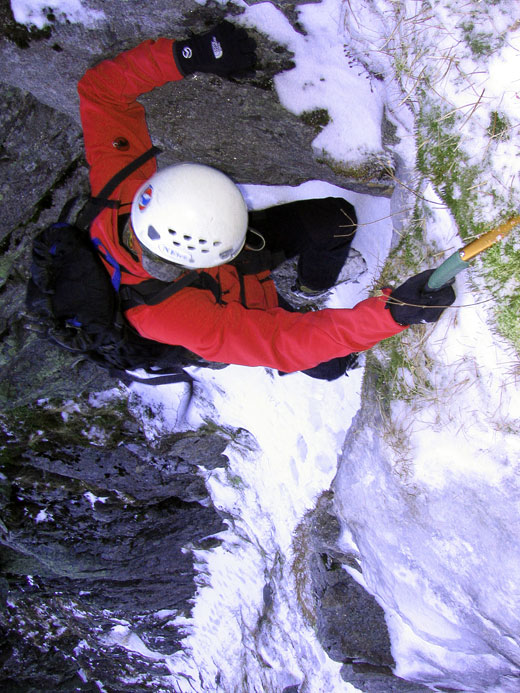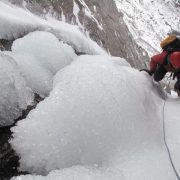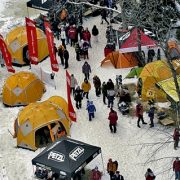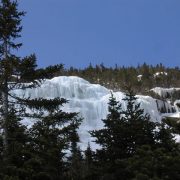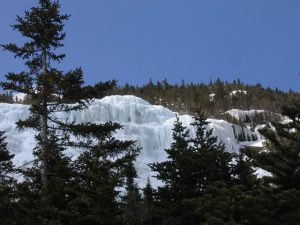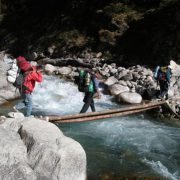Tag Archive for: ice
09/10 Ice Season Under Way!
/1 Comment/in Conditions, Featured Photos, Ice Climbing News/by NEice AdminPinnacle Gully, Mt. Washington NH
 Broken Spectre approaches the second belay on Pinnacle Gully, Mt. Washington NH. 10/15/09. The route had to cross the open river at that point to continue.
Broken Spectre approaches the second belay on Pinnacle Gully, Mt. Washington NH. 10/15/09. The route had to cross the open river at that point to continue.
Photo by Alden Pellett – Vermont Daily News.com
Rope Tips #1
/1 Comment/in Teck Tips/by NEice AdminSkinny Singles: How Thin Can You Go?
by Justropes.com
Modern single ropes keep getting thinner and thinner, pushing the envelope of what is possible for a balance of performance and weight savings. Is a “skinny” single right for you, and if so, how thin you should go? The answers depend on the type of climbing you intend to do with these thin single cords.
“Skinny” single ropes are those below 10 mm in diameter, and they seem to keep getting thinner each season. While these ropes typically range between 9.4 to 9.8 mm in diameter, the cutting edge at present is 9.1 to 9.2 mm (the Beal “Joker” and the Mammut “Revelation”). Maxim will have a new 9.1 mm single in 2006, and the envelope will be pushed even further by a new 8.9 mm single that Mammut will market in 2006!
These thin single cords typically weigh in around a lean 53 grams/meter (for 9.1-9.2 mm), 58 grams/meter (for 9.4-9.5 mm) and 62 grams/meter (for 9.7-9.8 mm). For comparison, a 9.5 mm, 60 m single rope is almost 1.5 pounds lighter than the equivalent 10.5 mm cord! Of course, you don’t get something for nothing. As common sense would dictate, the thinner a rope is, the fewer falls it can hold, and the less durable it will be. Super-thin skinny cords (e.g. 9.1-9.2 mm) have UIAA fall ratings of about 5, while the fall rating improves to about 6/7 for 9.4-9.5 mm ropes, and to about 7/8 for the more beefy 9.7-9.8 mm skinny ropes. Compared to the typical UIAA fall rating of 11 for a 10.5 mm single rope, one can see that the weight savings of skinny singles is gained at the cost of fall rating and durability.
While a few of the skinny singles are UIAA Sharp Edge rated, by far most are not. At present, only the Beal Joker 9.1 mm is UIAA rated for use as both a twin and half/double, as well as single. Using this rope as a twin increases the fall rating substantially.
So, how do you decide if a skinny single is right for you, and just how thin you should go? The key factor in choosing will often be whether you intend to use the rope to climb long, wandering, alpine-style routes, where rope drag will be an issue, or whether you intend to mostly climb routes that are linear and don’t wander, such as typically found at the local ice or rock crag, or cliff. Another important factor is whether you intend to use the rope for hard redpoint/onsight attempts, or for working routes and/or toproping.
Skinny singles are a solid choice for rock/alpine/ice climbers expecting to encounter many pitches and looking to save substantial weight. They still offer a solid safety reserve in terms of falls rating, and on many climbs, any rope drag can be controlled by careful use of longer slings (if the skinny single is also rated as a half/double, it can also be used in this format for any wandering pitches). They are often a great choice for climbers working hard routes for redpoints or onsights, where you don’t want extra pounds holding you down. On the flip side, they are probably not the right choice for working routes or doing a lot of toproping, where a thicker more durable 10+ mm single rope is going to shine. And they are probably not the best choice for use on any type of route, whether alpine, ice, or rock, that is going to wander to the point where the only way to control drag is with a double/half rope system.
As for how thin to go, just remember that the thinner the skinny single, the less falls it will hold and the less durable it is likely to be. So, most climbers considering their first thin cord will likely want to consider something 9.5 mm and up, saving the super-thin cords for redpointing, etc. If you decide to grab one this season, Beal, Esprit, Edelrid, Maxim, Mammut, and PMI all offer a range of great skinny single ropes. Get out there and climb safe!
IN PRACTICE – #1
/0 Comments/in Teck Tips/by NEice AdminBy Scott Backes
Alpine Mentoring.com
“IN PRACTICE”
One of the worst moments in every ice climb that is near the edge of our ability, is that instant when you stand with your tools in the ice, but your feet still on the ground. You’re looking at your belayer and he or she gives you the nod and its time to go. You feel the flush of chemicals course through you from head to toe. A more than reasonable doubt exists as to whether or not you can do it. There may be dread or a feeling of being over whelmed by the task at hand. You may even feel a little doomed as you bring that first foot up to start the process. You may even feel what I have felt on a number of occasions, “What the hell am I doing here?” So you commit to the route and lo and behold, it does suck to be you. The ice is worse than you hoped and it feels steeper than vertical. As you stop to place the first screw, the ice is airy and brittle. The screw won’t start, so you chop away some more ice and peck a little starter hole to help the screw get going, but it doesn’t help. Finally you feel the threads catch and you twist it home. The problem is, that half way through, the screw hits an air pocket and spins in with no resistance the rest of the way. It wobbles as you try to clip it. You start to feel the pump coming on almost immediately. Panic sets in and it’s time for either retreat or a real epic…
We’ve all been there. Grade III or Grade VII it doesn’t matter, if it’s near your ability you will undoubtedly encounter at least some of the fun described above. What the next two “IN PRACTICE” pieces will deal with is how to eliminate as many of epic makers as possible. The causes for our meltdowns are many, but can be divided up into two categories: The Physical and The Mental. This “IN PRACTICE” will deal with the physical details that can enhance or derail your efforts. The physical factors I am referring to are not your fitness, but rather all the actual implements and the physical circumstances that can affect the outcome of your performance. The next “IN PRACTICE” piece will deal with how to influence the mental and psychological circumstances of a difficult lead. These conditions obviously include will and courage but also include a number of relatively easily amendable attitudes and assumptions that are often undervalued or overlooked. Taken together the sum of these parts can change a routine ascent into an emergency room vacation or, if properly applied, change an out of control “Shakefest” into a difficult, but memorable personal best.
The physical manifestations of ice climbing are many. From the medium itself: the flow of ice we’ve chosen to climb, to the instep strap of our gaiters, everything used to ascend has weight in the relative difficulty equation. Lets start with our mode of expression, the ice. Ice is by its nature a changeable medium. We can use this malleability to shape our ascent; even shape our experience with it. Hooking up fragile features with little or no protection during an early season foray is completely different than thunking hero ice in 28 degree March afternoon. You are in charge when and where you go climbing and you are in charge of what routes you do. Be careful to chose your ice climbing objectives to match your needs. Early in my career, being in Canada in March helped me to have the confidence to tackle big routes right at the edge of my ability. The solid blue single swing ice meant that I would have good gear to keep my head in the game and the ease of placements allowed me to marshal enough power for the crux. Conversely, these days easier routes of wonderful quality often times are left untouched. With limited time and unlimited ambition I have often neglected easier classics in favor of an at my limit hit list. Early season ascents have changed that somewhat. By visiting areas right at the start of the season, I have been forced to backed off of climbs two grades below my “normal” ability and have put adventure into routes that I would have normally left for retirement days.
The knowledge of how ice forms and having enough experience to know what to expect, can make a difference in how we go about our ascent. After years of climbing steep pillars I finally started to notice some patterns in the way they formed and the way the difficulty was laid out due to those patterns. In most cases the first 15-35 feet are the technical crux of the route. Because it is the last section of the climb to form, the ice at the bottom of the pillar is more aerated, more brittle and steeper than anywhere else on the climb (umbrella roofs excepted). Obviously knowing this gives you a psychological edge, which I’ll talk about in the mental factor section. But, there are also concrete steps you can take if you know this information. Where are you going to stop for the first screw? Because the ice will most likely be funky, always make sure the first screw on your rack or clipper is a 22cm(long) one and that you have a screamer for it. Look carefully to see where the telltale white/gray ice gives way to blue. Is one side of the pillar a better color or better consistency (even if its steeper) than the other? Lastly look for rests-mushrooms to stand on, grooves to stem, or subsidiary pillars to lean against or stem out to and plan your ascent around them. My biggest mistakes on those early test piece leads were failing to look ahead and failing to reap the benefits of foresight.
There are two other physical contingencies’ that affect your experience on the lead. The first is the set-up of your gear. The second is the mobility of your clothing system. The single most important lesson I can teach you about gear, is that it needs to be dialed in to the point of invisibility. Your tools leashes, your racking system for your screws and other hardware, your crampon straps-basically every piece of gear you climb with needs to be set up correctly. The experience you are looking for, is one of having all your gear work together so well, that you never think about it. Every time you have to fight to get the right size screw, every time your leashes come loose, every time you are taken out of the moment to deal with circumstances outside of the climbing, you have failed. It might be as minor as a single curse-it might mean a leader fall. Take the time to have your gear in order before you launch up that cauliflower pillar, and you experience will improve immeasurable
The last issue I want to touch on, is mobility. Once again the principal I want to stress here is invisibility. Gone are the days when a set of heavy Gore Tex bibs and jacket was the only real choice to climb ice in. by taking advantage of “soft shell” technology, we can feel much more like rock climbers in tights and a tee shirt than a knight in armor. Scheoller, Powershield, and a host of other like fabrics have set us free. By taking advantage of these stretchy warm and durable fabrics we can let go of another distraction and concentrate more on the matter at hand-surviving our lead. The energy savings that come from unencumbered movement can be put towards the crux.
Taken together, all of the physical factors I have talked about can make a major difference in your next difficult lead. I hope you will take advantage of my learning curve. Next time I’ll talk about the intangibles that come in to play on difficult leads.
Scott Backes
Blogs
/0 Comments/in Ice Climbing News/by NEice AdminSome Ice Climbing Blogs
Festiglace 2007
/0 Comments/in Video, Video - Featured/by NEice Admin(c) Doug Millen
Madison Gulf
/0 Comments/in e-guide, Featured Photos/by NEice AdminThe Presidential Range, NH
Of the UP! & Ova…….. aka; Holy F*%*!
by Alan Cattabriga
After leaving a car at the Appalachia parking in Randolph, Tim, Ted, Doug and I are on the Great Gulf Trail in Pinkham Notch by 7am. The plan is to hike into Madison Gulf, climb the route, “Point”, then continuing up to Adams summit and down the other side via the Airline Trail to Appalachia.
Temps are in the upper 30’s but the trail is packed and hard. We decide to leave the snowshoes at the car. ( big mistake ) We figured the only place we would need them would be for the bushwhack from the Madison Gulf Trail to the ice. The approach is packed & the descent would be for sure.
The day is bluebird. The trail nice but all too soon, about halfway in, the sweet trail conditions go south fast. Once on the Madison Gulf Trail it was no longer packed. There were savage spruce traps, very little good footing and to add more to it, we kept losing the trail. The snow is so deep you are up higher in the tree branches, where trails are not trails. Blazes were non-existent.
Our good pace went to a crawl. In some places, literally. Hours slipped by as we lost the trail, again & again. Back-tracking every time to where we knew we were on it and trying again. At last we were in line with the ice and could see it good… we made the straight plunge. 7hrs. had passed since our departure at the Great Gulf trail-head to the base of the routes. Holy crap…
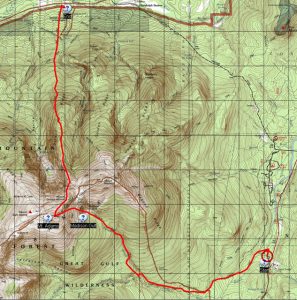 At the ice wall the sun is warm, the ice is huge and beautiful. My feet are soaked. Sitting on a rock, I wring out the socks and let my boots air out for a bit. Next we have 300’+ of ice, another bushwhack to the Buttress Trail then up the open summit of Adams. The ice is pure fun, the bushwhack above, because of the deep, hard-ish snow, is quite easy.
At the ice wall the sun is warm, the ice is huge and beautiful. My feet are soaked. Sitting on a rock, I wring out the socks and let my boots air out for a bit. Next we have 300’+ of ice, another bushwhack to the Buttress Trail then up the open summit of Adams. The ice is pure fun, the bushwhack above, because of the deep, hard-ish snow, is quite easy.
At the Buttress Trail we split up, I head up awesome snow to Adams and the others for the Star Lake Trail & Madison Hut.
The Airline Trail from Adams summit is in excellent shape, and it’s “knife edge” section bare rock & alpine plants. I lounge here for awhile wondering if I’m ahead of the gang. I decide ( mainly due to soaking wet feet) to book it down.
11hrs. 50mins after leaving, we are all down…. what a day! I’d go back in a heartbeat too.
Photos by Alan Cattabriga, & Doug Millen.
Crushing it in the "Can Rocks"
/0 Comments/in Trip Reports/by NEice Adminby Robert Ginieczki
There are few words that can describe the Canadian Rockies, especially along the Icefields Parkway corridor between Banff and Jasper. I guess the word ‘core’ and ‘dramatic’ are about all that come to mind for now, at least in the English language. So this story goes, my buddy, Stanislav, and I make some plans to head north to get on some ice, ice that’s bigger than the 2 full pitch laps we’ve been running on routes like Bridalveil and Ames here in Colorado. It was time for my bitchin’ to stop and buck up for a trip to the looming limestone walls of Canada.
Link to Story (PDF)
Source: Robert Ginieczki www.grizguides.com
Adirondack Mountain Guides Nepal 2009 Trip Report
/1 Comment/in Trip Reports/by NEice AdminBy Ian Osteyee
Porters crossing a foot bridge enroute to Namche.
On this season’s trip to Nepal we traveled through London, Delhi, and then on to Kathmandu.
Our goal – to climb the 700-meter water-ice climb, “Losar “, WI5, VI, in the Khumbu region of Nepal.
Our travel left the ordinary flow immediately as a 62- year old passenger had a heart attack between Newark and London, leaving myself and a former British Army medic as the two most qualified personnel on board. We managed to stabilize the unlucky fellow and turned him over to paramedics in Heathrow. Then, to add a bit more to the trip’s flavor, somewhere between London, Delhi, and Kathmandu half of our bags were lost.
Despite the bumps in the road, we arrived in Kathmandu happily met by Kami Tenzing, a Sherpa friend of mine. Kami is the man who made it possible for the blind Erik Weihenmayer to reach the summit of Everest. I met Kami while guiding Erik in the Khumbu previously, and Kami spent a few weeks visiting me in Keene this past summer. Kami is one of three Nepalese to have met the president of the U.S. – the King, the Prime minister, and Kami. Kami organized everything on the ground for us, and always had the answers, even to lost bags.
After celebrating the New Year in the ancient city, we flew up to the Khumbu and walked for two days up to Namche Bazar while acclimating to the thinner air at 3800 meters. The Khumbu region’s most famous ice route, “Losar”, was on our list of goals for the trip. Having done it the season prior, I was looking forward to climbing it yet again with the four other climbers in the Adirondack Mountain Guides Nepal party. As we came up the steep slope toward Namche, our first view of “Losar” revealed a thin, but continuous line of unknown quality. The following day’s approach to the base unfortunately revealed a waterfall not yet frozen, but trying. “Losar” was not in, but undeterred, this freed us up to start looking at other first ascent projects that I had scoped out the year before. Fortunately, our bags caught up to us in Namche thanks to the ultra-speedy Dzo-cow express and Kami‘s expedition magic. A Dzo-cow (“dzo-kyo“) is the hairy beast that you get when you cross a male yak with a cow. Things were gaining momentum as we took in the views of stunning peaks like Ama Dablam.
Loading up the Dzo-cow (“dzo-kyo“)
Moe Corrigan, Chonba Sherpa and I spent a day probing around in the forest on Kwongde, the same mountain “Losar” is located on. Right of Losar flows an obvious line that drops almost 2000 feet into the valley. The terrain leading up to it was steep and covered in bamboo. We worked our way upward through it, eventually finding a decent approach and a reasonable camp site. Tents were pitched and dinner served. A cold night followed in the forest on Kwongde, letting us get a good start as Tom Drake, Steve Smith and I headed up the long approach looking for the world-class ice ribbon we had seen. After a short scramble up through a rock slot and several hundred meters of “Bamboo 5” we found a boulder-filled, rock-walled drainage leading to the ice. It was incredible to come out of the slot and find the steep, long flow towering above. It looked dry and sublimated, but inviting. Excited, I starting up the line, testing each swing, It was hollow in many places. Traversing back and forth, trying to find the well-attached line, I gained ground. The arid nature of the environment made the ice very dry and brittle. I was thankful to have the Camp Awax tools in hand, the thin picks which make quick work of that type of nasty ice. The pitch seemed to go on and on and never let up. I was running out of shortie screws and hadn’t found enough ice for anything longer. From below I heard Tom yell, “ten feet”. Thankfully, with my 70m Bluewaters run all the way out, I looked up and there was a bulge that luckily took 16cm screws and it was “off belay!”. Starting off the day with a full 70 meters of 85 and 90 degree ice, often not thick enough for shorties, had us all feeling a little on edge. Nothing to do about it but continue upward. A glance up showed the second pitch was to be more of the same but easing off higher up on the route. Another 70 Meters of thin ice dancing and tentative stubby placements led us up as the angle eased and the climbing became less demanding. We laughed as remaining pitches cruised ever upward never getting harder than WI 3+. Pure joy in the climbing, gaining altitude up the massive mountainside. Success!
View of “Shaugdro”, WI5R, at center, with Losar, WI5, at left, viewed from near Namche Bazaar, Nepal.
Tom and Steve follow the steep lower pitches during the probable first ascent of “Shaugdro” WI 5R, 500m. Osteyee photo.
That evening back at the teahouse, Kami Tenzing assured us that the route had never been climbed. Just the same, we’ll call it a possible first ascent, and for the sake of a name, call it – “Shaugdro” WI 5R, 500m, ACB (As Climbed by) Ian Osteyee, Tom Drake, and Steve Smith.
While we were across the valley on “Shaugdro”, Mark Arrow and Moe Corrigan had already headed up to Lhabarma and were climbing in Phulebuk. Phulebuk is a great feature just out of the way from the main trail system. It is full of 400+ foot ice climbs that are all at about 15,000 feet, and until the last couple of years have gone unclimbed. We joined the duo the following day, and I enjoyed watching from a comfortable grassy spot as the two different teams went to work on their respective new routes. Mark Arrow and Moe Corrigan excitedly returned to the meadow after soaked up the bright warmth during the first ascent of “Desconnor”, WI 4, 150m, a steep flow that invites basking in the sun. A kilometer south, on their chosen flow, Tom Drake and Steve Smith worked their way up “In Sickness and in Health”, WI 3+, 150m, a more shaded route starting with a beautiful column, then cruised upward on stunning ice amid surrounding peaks like Thamserku 6608m and Kangtega 6685m. Up the valley stands Cho Oyu and across the valley are Arakam 6423, Cholatse 6335, and Taboche 6367. These ice routes are solidly placed in one of the world’s most beautiful places to climb. Tom, Steve, Mark, and Moe couldn’t have been more excited.
Tom Drake works his way up “In Sickness and in Health”, WI 3+, 150m. Photo by Steve Smith.
“Desconnor”, WI 4, 150m.
The following day Tom Drake and Steve Smith headed up to Goyko Ri (5360m), and Moe Corrigan, Mark Arrow, and I headed back down to Namche hoping to find “Losar” in better shape. Unfortunately, “Losar” was still a waterfall. Out of time for other big approaches, we went out scouting for future trips. While on our scouting trip, we did find one small route that we had time to do near the village of Thesho. It was an hour walk from Namche, but worth the trek to get one last new climb in. Located over yak pastures and small, stone dwellings, this small route,“Bolognesse” WI 4- , 30M, was a great way to finish the trip. It was named for the meal that sustained us on the journey more than any other; yak meat, watery tomato sauce, and noodles.
Osteyee leading up the small route,“Bolognesse” WI 4- , 30M. Somewhat reminiscent of a route in the Catskills or Pennsylvania but with a decidedly more mountainous view from the route.
Our trip was full of adventure – climbing and otherwise, but it was not over. Leaving Namche and back in Kathmandu, we discovered that Indian Air had cancelled our next days flight out of Nepal. Gathering our gear, we headed to the airport to see what we could figure out. Four hours of hustling, through crowds of the Hindu faithful there for a very special festival, along with some fancy talking got us on a flight that afternoon. Then another boring twenty hours of waiting in the Delhi airport when an excited airline employee hurriedly scrambled us to a different gate for our flight which still barely allowed for the baggage to be transferred to our Virgin Atlantic flight to Heathrow. Thankfully, without further delays we arrived back home, everyone satisfied and full of stories to share with friends for years to come.
Special thanks to Blue Water Ropes and Camp. The Blue Water Excellence ropes stayed dry and manageable through repeated uses in wet places, without any time to dry. The Camp Awax tools and Vector crampons performed flawlessly on some of the most dry, brittle and difficult ice conditions.
– Ian
Editors note: Ian Osteyee is owner of Adirondack Mountain Guides in Keene, N.Y., and AMGA-certified guide with over 25 Years experience. In 2008, Osteyee guided famed blind climber and Everest summitter Erik Weihenmayer and Rob Raker up the huge ice route, “Losar”,WI5, VI, 700M, in Nepal.
Ouray Ice Festival 2009
/0 Comments/in Events/by NEice AdminThe Ouray Ice Festival was begun in January of 1996 by ice climbing pioneer Jeff Lowe In 2001. Held this season January 9 – 11, 2009, the event features a gathering of international ice climbers, gear manufacturing exhibitors, and vacationing visitors excited by the chance to watch the scene from cliff-side platforms and trails.
Ouray Ice Fest Blog by Alden pellett

North East Ice
Your ice climbing connection for New England, the Northeast and Beyond!

